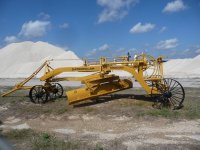Start with a level spot, flip the grader blade around facing away from you... and move backwards. That is the only way I have found to not have the shape of the earth effect what the blade is doing behind you.
Or you would need to manually raise/lower the box/grader blade to take high spots that your driving over.
If you have turnbuckle AKA 'chain' stabilizers supporting your Three Point Hitch Lower Links do not PUSH the Box Blade with tractor in reverse without considering carefully if you will bend or break the unsupported stabilizers.
Cautiously PUSHING a Box Blade is a reasonable proposition only with rigid stabilizers supporting the Three Point Hitch Lower Links. Caution advised.
I use the Ratchet Rake bucket attachment for dragging dirt to fill depressions.
Ratchet Rake on the FEL bucket, Box Blade on the Three Point Hitch.
6/09/2016
This post concerns Ratchet Rakes Vs. light Box Blades, such as the 60" Land Pride BB1260/346 pounds/69 pounds per foot.
I searched for the weight of kubota L3301 bucket but could not find a number. I presume L3301 bucket weighs approximately 240 pounds, extrapolating from other kubota specs. 68" Ratchet Rake weighs 88 pounds. Adding 240 + 88 = 328 pounds, pretty close to 346 pounds of BB1260 Box Blade.
In addition, the (operator controlled) weight of the FEL frame bears on the Ratchet Rake. Likewise, weight of the Three Point Hitch bears on the Box Blade. FEL frames weigh much more than ( 3X? 4X?) Three Point Hitch components. So, including some FEL weight, I guesstimate that ground contact pressure on Ratchet Rake and BB1260 would be at least equal, perhaps greater pressure on the Ratchet Rake.
Further in Ratchet Rake's favor you have articulation of bucket/RR combination in two planes from the operator's station and 1-1/2" serrated teeth on the Ratchet Rake.
Box Blade can be raised and lowered hydraulically from the operator's station. Box Blade angle of attack is adjustable via the Three Point Hitch Top Link, but not from the operator's station. Standard Box Blade does not have rippers, standard is a smooth cutting edge.
Ratchet Rake is capable of tearing up sod with its serrated teeth, the initial operation in much grading. The Ratchet Rake will not pull as large a load as a Box Blade but it may pull 35% of capacity of BB1260 per pass, with faster cycles. Ratchet Rake is more intuitive in operation than a Box Blade, which requires considerable experience to operate efficiently.
This is why I feel the Ratchet Rake is superior to light Box Blades for LIGHT grading.
I own both a Ratchet Rake and a Rollover Box Blade.
When I have heavy grading to do, I mount my 60"/625 pound (125 pounds per foot) Bush Hog (brand) Rollover Box Blade on the tractor's Three Point Hitch AND the Ratchet Rake on my FEL bucket.
